
Dispatch from KMDH, Carbondale/Murphysboro, Illinois: Standing on my wing, I look down the long double row of airplanes. Like an old-style barn dance, the two lines of planes face each other, spinner to spinner, across a wide taxiway. We’re arranged from fastest to slowest; the fastest planes on the east, the slowest planes on the west.
I’m, uh, pretty much as far west as you can get and still be in the race.
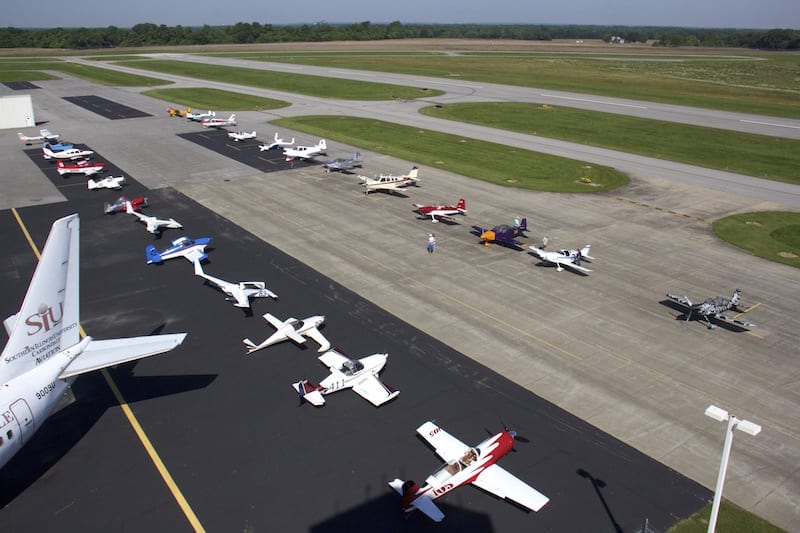
A bird’s eye view from the Southern Illinois Tower of the race planes lined up and ready to race. Race 53 is the second to the last plane on the right-hand row. The planes are arranged on the ramp in launch sequence, allowing for an orderly rollout that was elegant-looking for the spectators. (Photo by Lisa F. Bentson)
The Kitfox is to my right. The Cessna 150 Aerobat, my direct competitor in the FAC6 class in this latest race of the Sport Air Racing League, is directly across from me. Everyone else is to my left.
Still, it’s a beautiful sight, 24 race planes lined up, ready to dance across the Illinois and Missouri countryside. The parking of the planes in launch order is purely organizational, but it’s also fine choreography.
When the Ramp Marshall gives the signal, each plane will pull out, first from one side, then from the other, the two columns of planes merging into one chain to taxi to the active runway.
Then the real dance will begin.
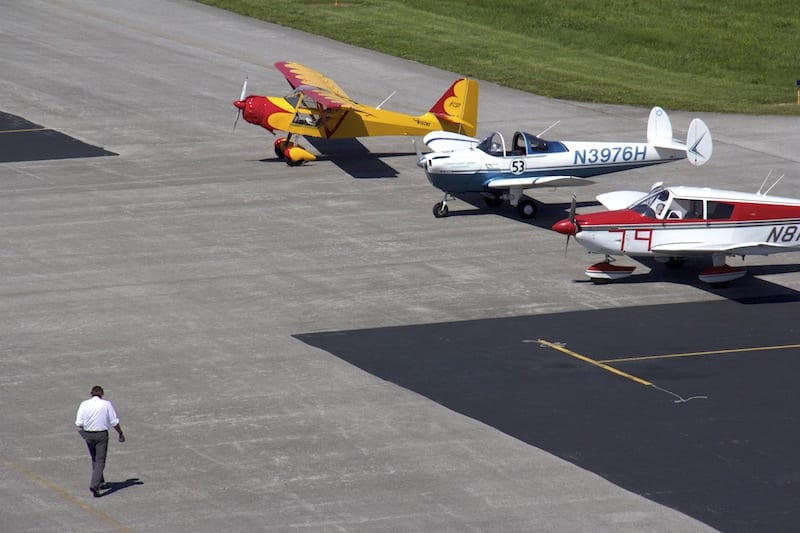
Air racer William E. Dubois makes his way across the apron to Race 53 shortly before engine start at the Big Muddy Air Race at the Southern Illinois Airport. (Photo by Lisa F. Bentson)
But first, I need to finish readying Race 53. I did a thorough preflight and engine test before the race briefing, and moments ago, before I climbed up on the wing to take in the view, I did a sharp-eyed walk-around to make sure nothing had gone amiss while I was away. Now it was time to ready the cockpit.
Like most of the previous five races this season, it’s mind-numbingly hot. I wrap my pale blue cooling cloth — a gift from the Aircraft Owners and Pilots Association’s Hat in the Ring Society at last year’s Red Bull Air Race finals —around my neck, tucking it in under my flight shirt, and slip into the cockpit.
Race 53’s interior is a beautiful dark denim blue with black leather trim. The interior gets rave reviews at airshows, but today the sexy leather trim scalds my skin through my pants as my fingers gingerly dance with the blistering seatbelt buckles. Even with four collapsible Rosen sunshades strategically placed, my plane is a virtual greenhouse.
A bad start
I reach down into the foot well under the instrument panel where I stashed my Garmin 39D and iPad Mini to keep them out of the direct sunlight. Retrieving both, I turn on the Garmin, position it over the Velcro on the dash, and push it into place. I snap the iPad into the RAM Cradle that attaches to my windscreen support rail, and turn it on.
Nothing happens.
I press the button again.
Nothing. The screen is pitch black.
No… wait… there’s something. Super faint. I lean forward, squinting in the bright light. A red icon. The iPad has overheated. Shut down.
A wave of nausea rolls over me. I have no navigation. At the end of the line of planes a throaty roar breaks out, followed by the distinctive power whine of a radial engine starting.
The dance has begun, and I’m blindfolded.
I whip the cooling cloth off my neck, and wrap the iPad in it. I wave my hands frantically over the blue bundle, trying to create a draft — hoping this attempt at artificial respiration will bring the dead tablet back to life.
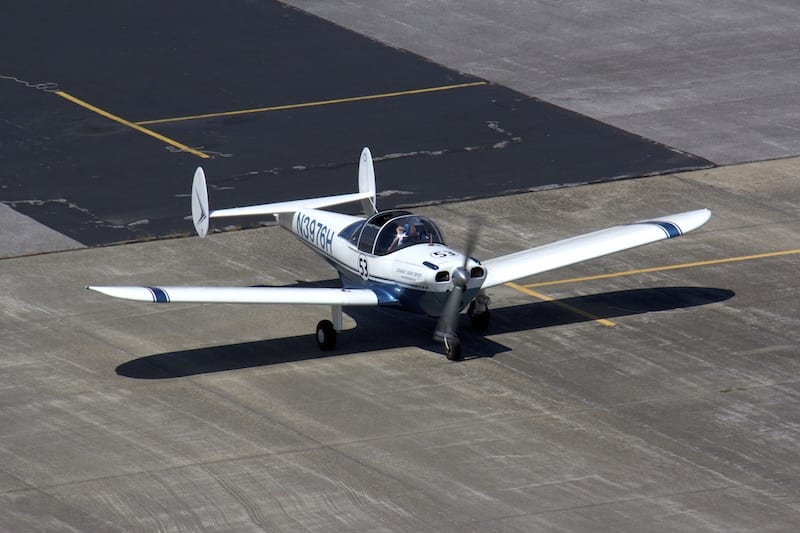
Taxiing to the active runway with an overheated iPad, race pilot William E. Dubois is using his iPhone for navigation. (Photo by Lisa F. Bentson)
The plane next to me starts. I look out my windshield and to the left. Across the aisle the prop begins spinning on a shiny red and white Grumman Cheetah. A shiny red and white plane with checkered race markings: Team Ely in Race 55 is powering up.
If they only knew what was happening in my cockpit right now, they’d be laughing their asses off.
The champs
Mike and Linda-Street Ely, a.k.a. Team Ely of Race 55, are the four-time season champs in the Factory Category. They are the folks I set out to knock off the pedestal, but it’s proving harder than I expected.
Here’s the deal. Their plane, cleverly named the “Elyminator,” is a damn fast plane for its Class, FAC5FX. As far as I can tell, looking at league statistics, it’s completely undefeated. The Elys win every race they run.
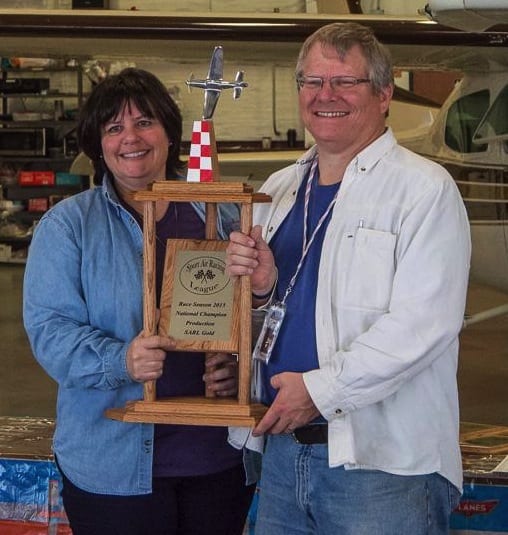
Linda Street-Ely and Mike Ely, of Race 55, with their fourth season First Place Champion trophy in the Factory Category at the end of last year’s season. (Photo by Jo Hunter)
If Team Ely shows up, you know they’ll take home 100 points towards a fifth-season gold trophy. That assumes no one else in their Class is in the race. If other FAC5FX planes show up, you can pretty much count on Team Ely notching up another 10 points per competitor for defeating each one.
Not so of me and Race 53. While I’ve actually defeated every FAC6 plane I’ve flown against so far this season, it’s a winning streak that’s bound to end. Maybe in this race. Maybe in the next.
The fact is that I’m in a category in which I’m as likely to be beat by almost any competitor as I am to be victorious.
Actually, this total uncertainty is…exhilarating.
What would be the fun in certain victory?
Still, I do like to win, and my plan was to beat the Elys by simply racing more races than they did to trump their point total by the end of the season. Long before the first race, I carefully studied the League statistics from 2012, 2013, 2014, and 2015 and judged that I could fly more races than Team Ely typically did.
But I made two mistakes.
The first was that I assumed they flew the number of races they could fly. I was wrong. They flew the number they needed to fly to keep in first place.
The second mistake was graver. I hadn’t stopped to consider the Challenger Factor.
I hadn’t stopped to consider how they’d react to my coming after their title.
Winners and losers
For me to come in first place at the end of the season would mean that Team Ely would drop into second place. Still winners, right? Uh…no. That’s not how many air racers see it.
Reno racer John Parker famously said, “Second Place is First Loser.” I think that would resonate with Linda, whom other racers have described to me as being “highly competitive.”
Not unexpectedly (in hindsight) Team Ely are pulling out all the stops to make sure that they stay the first place winners and that I am the first loser. It doesn’t benefit me much that they can read my entire playbook online and in the pages of General Aviation News, either.
But in an odd way, Linda Street-Ely recently returned the favor. In her Ely Air Lines blog she threw down the gauntlet and laid out in black and white how she felt about “our” competition. It was insightful. Not winning a fifth year in a row would be hard on her. But worse, the thought of losing to an Ercoupe — of all airplanes — is completely mortifying.
She writes, “The thought of the Elyminator standing second to an Ercoupe, in official, saved-forever records, with end-of-year photos, and us holding a second-place trophy is motivating me to change a lot of plans this year. Meanwhile, William is chronicling the entire season’s competition, along with his dream to swipe that first place trophy, for everyone to read in the aviation newspapers.”
Clearly, my dream is her nightmare. But she ends with a spirited challenge: “If ever there were a time to Elyminate, it is now. Game on.”
More to lose
Of course, if you don’t want to risk losing, you shouldn’t take up racing. Or you should win once and then very publicly announce that you are stepping down and giving others a chance. That’s called going out on a high note, and technically keeps you from ever being the first loser.
Still, speaking of losing, I can see that Team Ely has more to lose that I do. As the challenger, I don’t have as much at stake. I either win or I make a good showing. It’s not the same as losing to a challenger.

Lift off! Race 53 heads down Runway 24 toward the start line. Some pilots climb quickly, then dive on the start for extra speed; others stay low after rotation. (Photo by Lisa F. Bentson)
The only thing that makes me sad is that I don’t think the Elys are having as much fun defending their title as I am trying to steal it. They seem focused, perhaps frantic, about making the races and being sure I’m good and beaten.
On the other hand, I’m enjoying every aspect of the racing: The trips, the people, the challenges. It’s all good.
Game on, indeed
Will my challenge to the champs be successful? Originally, I thought so. Now I’m not so sure.
Team Ely is ahead in points and will be hard to catch. My plan was to out-race them in volume, but Linda’s statement that the team was motivated to “change a lot of plans this year,” tells me that I should expect to see their shiny red and white Grumman Cheetah with the checkered race markings at every race I go to.
And yes. I’m now committed to going to all the remaining SARL races of the season.
Game on, Linda.
How will the point totals play out? It’s impossible to say. It will be close, damn close, all year. And the Elys have two other advantages over me.
First, they have the advantage in having an instrument-certified plane. Race 53 is not instrument-certified, and that means that weather that might prevent me from even getting to a race won’t stop the Elys.
Their second advantage is in being a two-pilot team. If one of them has a family or work conflict, or an illness, the other one flies the race. I have no backup.
Next week’s race is in far-far away Washington State. I had hoped that Team Ely wouldn’t go, confident in their likelihood of victory.
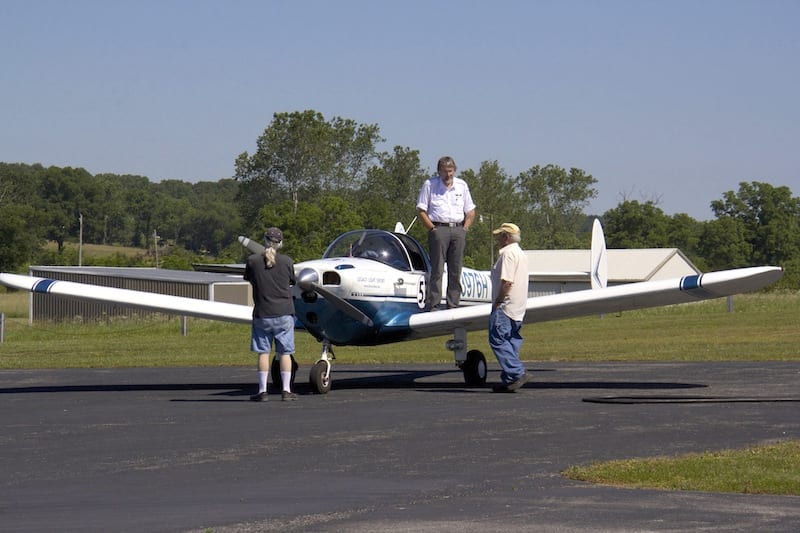
Enjoying the ride. Air racer William E. Dubois chats with local pilots at a fuel stop at Willow Springs, Missouri (1H5), in route to the 2016 Big Muddy Air Race. Race 53 has a limited range, requiring 200-mile legs on cross countries to reach the SARL races, but Dubois reports enjoying visiting so many small airports and meeting the locals. (Photo by Lisa F. Bentson)
For me, despite the daunting distance at my cruise speed, the effort seems worthwhile even though I’m slated to compete against a plane with greater horsepower and a higher “book” speed.
I figure that even being the first loser would give me 80 points and put me, at least briefly, ahead of the Elys for the first time this season. They aren’t signed up yet, but I just know that they will be there. Probably showing up at the last second to burst my bubble. That’s happened twice this season so far.
Still, anything can happen, and I’m in it until the final checkered flag of the season.
Checkered flag
But as I pull onto the active runway, my cell phone in my lap for navigation, I have smaller fish to fry than the Elys.
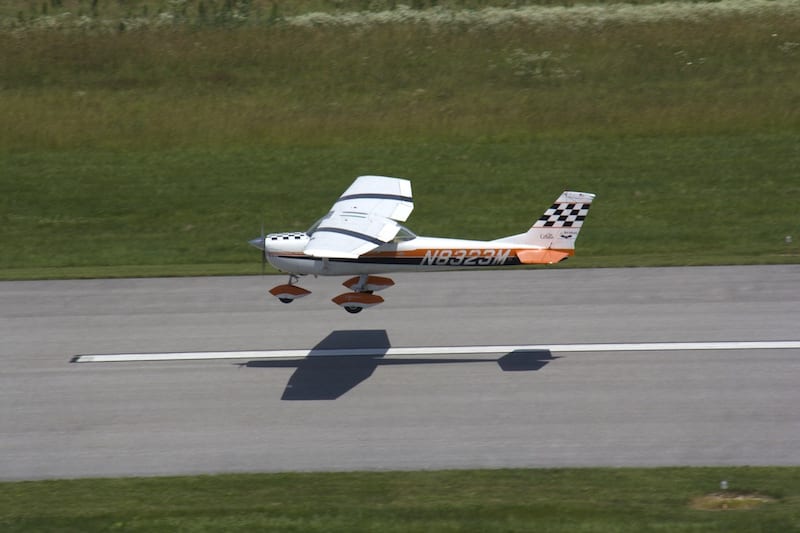
Race 23, with Dan Bean at the controls, in hot pursuit of Race 53. The Cessna 150 K Aerobat has a 100 horsepower engine, quite a bit more powerful than Race 53’s 85-horse Continental, but the Cessna has a more draggy design than Race 53. It was anyone’s guess which plane would be faster. Until the awards ceremony, even the two pilots weren’t sure who won the heat. (Photo by Lisa F. Bentson)
Right behind me is Race 23 with Dan Bean at the controls. Race 23 is a “K” model Cessna 150, the Aerobat model with the race markings. Frankly, I always found the 150s to be ugly little airplanes. To my eye, they look a bit like mosquitoes, the way they perch high on their landing gear with their wings held above their bodies.
But it’s not a plane to be taken lightly in my Class. It has more power than I do, and a much higher rated speed. This one is in pristine condition, too, not that you can make a statement about the health of an airplane’s engine based on its paint job.
Still, if I can beat Race 23 I’ll get 110 points, which will close the gap between me and Team Ely to only 20 points, as they are flying unopposed in this race.
Of course, if I lose and come in second place, I only get 80 points, and the Elys pull ahead by 50 points. That would leave me, assuming we both make it to all the remaining races, needing to beat five planes to even tie with them.
A tall order, indeed.
On my tails
Flying on my phone, I’m not confident about the accuracy of my position. In most races, if you cut a corner, you get a 15-second penalty. During the race briefing we were told that a corner cut was disqualifying in the Big Muddy Air Race. I decide to play it safe and take the corners wide.
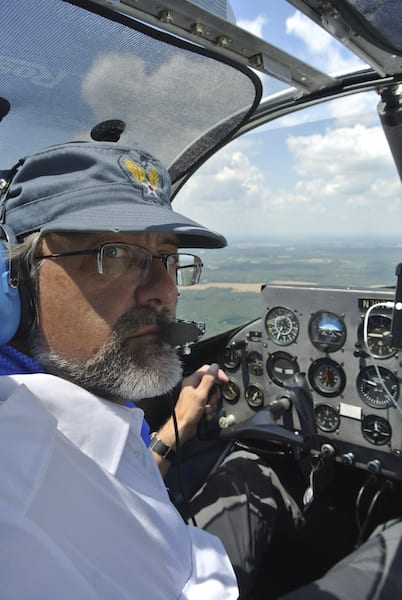
In the race cockpit after making the first turn the author scans for Race 23. Based on radio calls, he knows the other plane is hot on his twin tails. (Photo by William E. Dubois)
Even if the Cessna beats me, it’s better to have 80 points than none. But I’m feeling confident and relaxed. The fact that the little high wing was put behind me in the launch order tells me they expect him to be slower.
I’m now over Pinckneyville-Du Quion Airport. Watching the turn point disappear under my wing, I count out loud, “One thousand one, one thousand two, one thousand three, one thousand four, one thousand five.” Then I click my mike and start my turn. “Pinckneyville traffic, Race Five-Three, Turn One, Pinckneyville.
Not 20 seconds pass before the radio crackles in my headset, “Pinckneyville traffic, Race Two-Three, Turn One.”
Crap! The Cessna is right on my tails! He’s closed the gap between us before the first turn! My throttle is firewalled. I’m at the lowest altitude I can be at. I’m losing. And there’s not a damn thing I can do about it. I feel helpless, trapped, angry. Superior power is besting me. I scan the sky around me, but cannot see him.
I expect the passing call any second, but it does not come. At turn two, above Sparta-Hunter, his call is right on my heels. Now we are driving for the Chester Bridge over the Mississippi. I take the turn tight, as close to the turn point as possible. A thermal has bumped me up in altitude. I bank as sharply as I dare and let the nose fall out of the turn to keep my airspeed up, while cutting as short a ground track as possible. I’m desperate to gain ground on my competitor.

A tug pushes a barge upriver the day before the race in this image shot on Race 53’s practice run. The race’s short course crossed the river five times. (Photo by Lisa F. Bentson)
The next leg is 25 miles, and crosses the mighty Mississippi river five times as the wide brown river snakes lazily under our arrow-straight course. Turn four is the east pylon of a pipeline bridge. Turn five is over the levy on the Big Muddy River near where it flows into the Mississippi. The last turn of the short course is around a yellow water tower at Makanda that has a big smiley face painted on it.
I’m not smiling.
I contact the tower at Southern and am cleared for a low pass over the finish line on runway 36 Left. I’m 10 miles out. I enter a power dive and flash down the runway at 50 feet. Out of the corner of my eye I see the checkered flag drop.
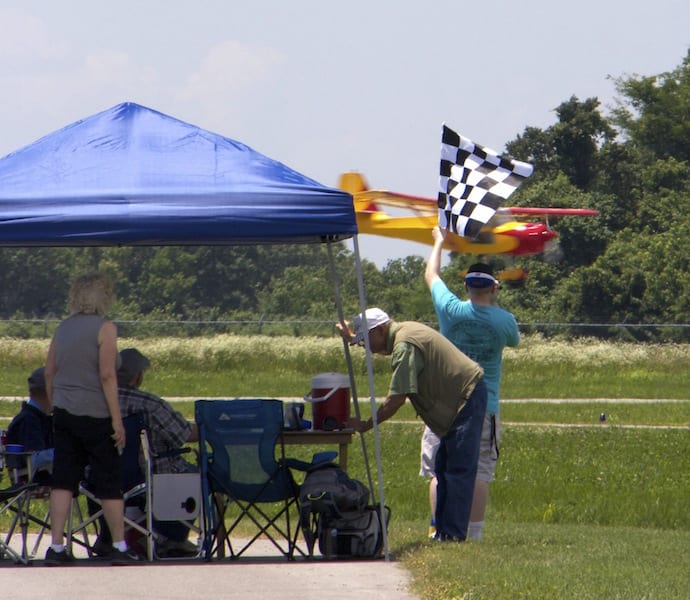
Timers drop the checkered flag on the last plane back, Race 132, a Kitfox 4 piloted by Mark Bybee, ending the 2016 Big Muddy Air Race. Although the slowest plane at 91.38 miles per hour, Bybee took first place in his Class by the virtue of being the only Experimental Light Sport in the race. By comparison, Canadian Wayne Hadath, Race 14, flew his F1 Rocket to the fastest speed in the race at 224.32 miles per hour. (Photo by Lisa F. Bentson)
As I pull up and enter a teardrop approach for Runway 24, I have no idea if I came in first place.
Or if I’m the first loser.
My League Points: I did win! I was on pins and needles until the awards ceremony, but I was awarded the trophy for first place in my class, and 110 league points (100 for the victory and 10 for beating the other plane). I now stand at 640 points. Team Ely is barely ahead, with 660 points.
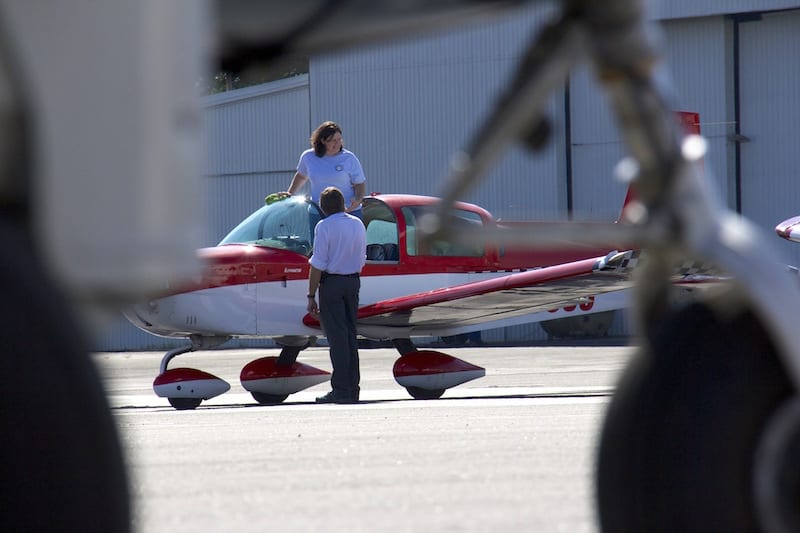
After the race, William E. Dubois of Race 53, and Linda-Street Ely of Race 55, congratulate each other on their runs at the 2106 Big Muddy Air Race. Although becoming increasingly fierce competitors, the competition remains friendly. At least on the ground. After all, air racers are still one big family. (Photo by Lisa F. Bentson)
Final official speed put me at 111.28, my worst speed of the season, but fast enough to beat Race 23’s 107.79 miles per hour. Only one minute and 54 seconds separated our elapsed times on the course. Seconds count.
My League Standing: I remain in second place in the Factory Category, but have dropped to third place overall in the league behind point total front runners Team Ely and Ken Krebaum of Race 118 in the Experimental Category, who bested two other planes at the Big Muddy Air Race to up his point total to 650.
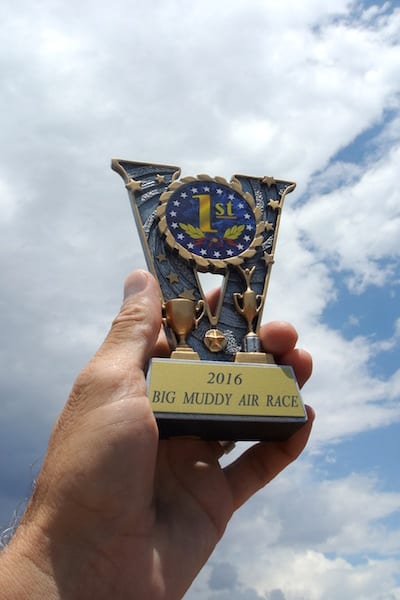
The 2016 Big Muddy Air Race First Place Trophy for FAC6 Class, won by William E. Dubois of Race 53. (Photo by William E. Dubois)
Source: http://generalaviationnews.comAir Racing from the Cockpit: The champs and the challenger